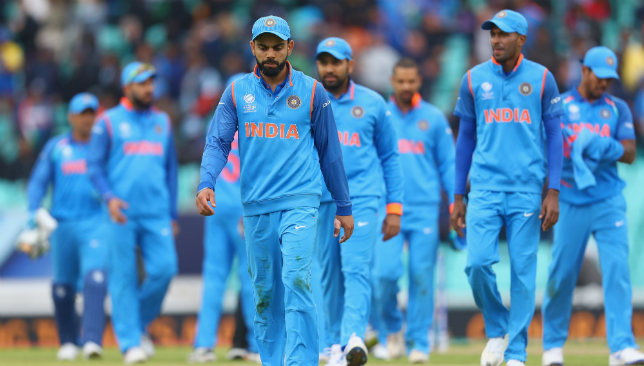
England, Australia, South Africa and India – that was everybody’s answer when asked to guess the four semi-finalists for this 2017 Champions Trophy. Australia have been eliminated after losing to England on Saturday, and, on Sunday, one of either India or South Africa will be eliminated from the competition.
That is the nature of this tournament, at least of this format when the ICC envisaged it in 2002. Back then, the group stage was longer and lethargic, as Sri Lanka played host. Rain spoiled most of the games, especially the final (twice!).
More to the point, the weather has played its part in this edition too, but should be kind enough to allow India and South Africa a full shot at semi-final qualification. The format though, in its permutation zeal, as already placed one of them on the chopping block.
Of the two teams, South Africa still have some reason for grievance. Rain hampered their game against Pakistan in Birmingham, when they were squeezing the opposition with some tight bowling. They did get to bat in bright sunshine though, and in the normal scheme of things, 219/8 can never be considered a sufficient total in one-day cricket nowadays.
Huge game tomorrow! Will it be #India or #SouthAfrica who progress from Group B?
— Sport360° (@Sport360) June 10, 2017
Full #CT17 preview ⬇️
📰https://t.co/2kBzZyAOXw #INDvSA pic.twitter.com/UDlmwdf4Vv
Is 322 a good-enough target though? Sri Lanka proved otherwise on Thursday, as they stunned India into submission. At the start of this competition, maybe England or South Africa had the firepower to overcome such a total against an Indian bowling attack boasting of quality pacers, an exuberant all-rounder and two world-class spinners.
Lanka tore that script apart, and a day before their must-win game, the Indian think-tank will be busy wondering what indeed is a good score at the Oval now.
The bigger question is how do you defend a target such as this. There wasn’t anything wrong with how India approached the Lankan chase. They bowled as per plan, but with their lone spinner (Jadeja) going for runs, Virat Kohli will be back to the drawing board on Saturday.
The India-South Africa game on Sunday will be played on the same strip as India-Sri Lanka on Thursday. Could it be a chance for R Ashwin to make his first appearance in this tournament?
Right, now to #INDvSA. Day in day out, South Africa win more ODIs but nobody is more jittery on the big day. Good match-up, India nose ahead
— Harsha Bhogle (@bhogleharsha) June 10, 2017
“We have definitely looked at the last game and where we can make a bit of change.There are all kind of possibilities. You can have any sort of combination possible for us starting tomorrow,” said Kohli in the pre-match press conference.
There is one combination that won’t change for India though, and it is the opening pairing of Rohit Sharma and Shikhar Dhawan. It was in the 2013 Champions Trophy that the duo first came together, and set that tournament afire with some lusty hitting against South Africa and West Indies. Together they scored 382 runs in 5 matches at 76.40, inclusive of 100-plus partnerships.
The success of this new opening pairing surprised one and all, giving India a set platform for the years to come. In the 2015 ODI World Cup, the pair put on 742 runs in 8 matches at 49.96. They are back at it again, in 2017 now, belying poor form and injury in the months gone past.
They have already scored 274 runs in 2 matches against Pakistan and Sri Lanka. Needless to say, India will be heavily dependent on them to provide a platform once again on Sunday.
“It’s been three-four years now,” said Dhawan, about opening with Rohit. “Once you know the person on and off the field, you get comfortable as well. We create balance for each other. We have been opening for a long time, and that stability creates consistency.”
“There is no miracle really. We keep stealing a lot of singles. Strike rotation is very important because our left-right combination causes a lot of problems for the bowlers. They have to keep changing line and length,” added Rohit, after the Lanka game.
First time India lost after a century stand from Rohit Sharma and Shikhar Dhawan in ODIs. Won all during their previous 9 100+ stands. #CT17
— Sampath Bandarupalli (@SampathStats) June 8, 2017
It sits in well with how team India executes their batting plans. This is not a slam-bang outfit, and they believe in a solid base for 25-30 overs with wickets in hand, before aiming to double their score in the last 20 overs.
Of course, the vagaries of international cricket do apply herein. This plan worked against Pakistan in Birmingham as Kohli, Yuvraj Singh and Hardik Pandya teed off. It didn’t against Lanka on Thursday as India were reduced to 179/3, and Dhawan had to do the rebuilding job with MS Dhoni.
As such, from an Indian point of view, there is nothing different to be done against South Africa on Sunday atleast in terms of batting. Maybe they can accelerate a bit in the middle overs, but that is once again down to situation. The key for Kohli will be to select a bowling attack with perfect balance in pace and spin, one that covers all bases.
For, they are facing the world’s no.1 ranked ODI side, with no inherent weakness, atleast on paper.